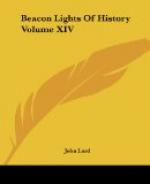BY WILLIAM HAYES WARD, D.D., LL.D.
It was twenty-three long centuries ago that a Greek soldier of fortune, who had the honor to be also a disciple of Socrates, was leading ten thousand mercenaries back to their native land after their famous failure to set the Younger Cyrus on the throne of Persia. Clearchus and the other generals had been treacherously murdered. Dispirited, almost hopeless, on their way to the longed-for Black Sea, in anticipation of the perilous and tedious journey, past wild mountains and wilder Kurds, they toiled up the valley of the Tigris River. Of one incident of their journey their historian and leader makes no record. They reached the spot where now stands the city of Mosul. On the bank of the river their eyes fell on a bare and lofty hill. They did not know, they never suspected,—Xenophon wrote no word of it,—that under that hill lay buried the ruins of one of the mightiest conquering cities that had ever ruled the world. From the palaces of that hill, Ninus and Semiramis and Sardanapalus had led their conquering armies, all now covered with silence.
Two centuries earlier, in 606 B.C., there had occurred one of the most tremendous catastrophes recorded in all the grim annals of war. After a thousand years of primacy in the East, but twenty years after the death of Sardanapalus (the Greek name of Asshurbanapal), who had carried his armies to Egypt and had made his capital the centre of the world’s culture and magnificence, as it was of its cruel and hated power, Nineveh was captured, buried, and utterly desolated by a horde of savage Scythians from the mountains of the north and east, such people as we now call the Kurds. Its palaces had no lofty Greek columns to stand for memorials, as at Palmyra or Persepolis; and when the outer casings of brick and alabaster were cracked away, and the ashes of the upper stories and the clay of the inner constructions, soaked by the rains, covered the ruins of temple and palace, nothing was left to mark the site but the grass-covered hill. No wonder that the learned scholar of Socrates saw nothing, knew nothing of the city, most glorious and most detested of all the cities of the earth. But in its day the overthrow of Nineveh and the destruction of the Assyrian Empire had been the most terrible event in the world’s history. How the Hebrew prophets gloated over it! “Where now is the den of the lions, and the feeding-place of the young lions, where the lion and the lioness walked, the lion’s whelp, and none made them afraid? Wo to the bloody city; it is all full of lies and rapine; the prey departeth not. The noise of the whip, and the noise of the rattling of wheels, and prancing horses, and bounding chariots, the horsemen mounting, and the flashing sword, and the glittering spear, and a multitude of slain, and a great heap of corpses, and there is no end of the bodies. There is no assuaging of the hurt; thy wound is grievous; all that hear the report of thee clap their hands




